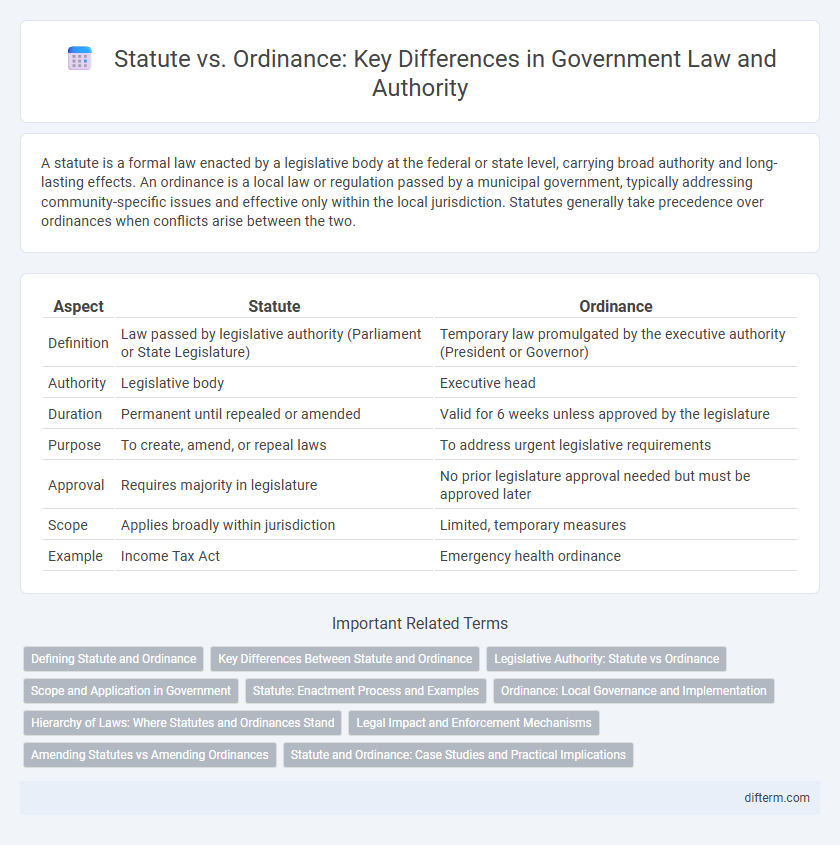A statute is a formal law enacted by a legislative body at the federal or state level, carrying broad authority and long-lasting effects. An ordinance is a local law or regulation passed by a municipal government, typically addressing community-specific issues and effective only within the local jurisdiction. Statutes generally take precedence over ordinances when conflicts arise between the two.
Table of Comparison
| Aspect | Statute | Ordinance |
|---|---|---|
| Definition | Law passed by legislative authority (Parliament or State Legislature) | Temporary law promulgated by the executive authority (President or Governor) |
| Authority | Legislative body | Executive head |
| Duration | Permanent until repealed or amended | Valid for 6 weeks unless approved by the legislature |
| Purpose | To create, amend, or repeal laws | To address urgent legislative requirements |
| Approval | Requires majority in legislature | No prior legislature approval needed but must be approved later |
| Scope | Applies broadly within jurisdiction | Limited, temporary measures |
| Example | Income Tax Act | Emergency health ordinance |
Defining Statute and Ordinance
A statute is a formal written law enacted by a legislative body such as parliament or congress, establishing binding legal rules applicable nationwide or within a state. An ordinance is a temporary or permanent law or regulation issued by a local government authority or executive branch under delegated powers to address specific local issues. Statutes have broader authority and undergo legislative procedures, while ordinances typically address immediate concerns at municipal or regional levels.
Key Differences Between Statute and Ordinance
Statutes are laws enacted by a legislative body at the national or state level, whereas ordinances are laws or regulations issued by local government authorities such as municipal or city councils. Statutes typically require a more formal process including multiple readings and approvals, while ordinances can be enacted more quickly to address local issues. Statutes hold broader jurisdiction and override ordinances when conflicts arise, reflecting their higher authority within the legal hierarchy.
Legislative Authority: Statute vs Ordinance
Statutes represent laws enacted by a formal legislative body, such as a parliament or congress, establishing permanent legal standards with broad jurisdictional authority. Ordinances are typically laws or regulations issued by local government entities or executive authorities, often designed to address immediate or specific community needs within limited geographic boundaries. The primary distinction lies in the source of legislative authority, where statutes derive power from elected legislatures, while ordinances originate from delegated local governmental powers or executive agencies.
Scope and Application in Government
Statutes are laws enacted by the legislative branch with broad, long-term application across entire jurisdictions, establishing general legal principles and frameworks. Ordinances are local laws or regulations passed by municipal or local government bodies, targeting specific issues within limited geographic areas. Statutes typically override ordinances when conflicts arise, reflecting the hierarchical authority in government lawmaking.
Statute: Enactment Process and Examples
A statute is a formal written law enacted by a legislative body through a rigorous process involving proposal, debate, and approval by elected representatives, followed by the executive's assent. It typically addresses broad and significant legal matters, such as the Civil Rights Act or the Clean Air Act in the United States. Unlike ordinances, statutes have nationwide or state-wide applicability and require legislative authority for enactment and amendment.
Ordinance: Local Governance and Implementation
Ordinances serve as critical legal instruments in local governance, enabling municipal authorities to address community-specific issues swiftly and effectively. These regulations, enacted by local councils or governing bodies, facilitate the direct implementation of policies tailored to the socioeconomic and environmental needs of a locality. Unlike statutes, ordinances have a more immediate effect on local administration, ensuring responsive governance and efficient enforcement of public order at the grassroots level.
Hierarchy of Laws: Where Statutes and Ordinances Stand
Statutes are laws enacted by legislatures at the state or federal level and hold higher authority in the legal hierarchy compared to ordinances. Ordinances are local laws or regulations passed by municipal or county governments and must comply with applicable statutes. In cases of conflict, statutes prevail over ordinances, ensuring state or federal law supremacy within the jurisdiction.
Legal Impact and Enforcement Mechanisms
Statutes are formal laws enacted by legislative bodies, carrying the highest legal authority and ensuring widespread applicability and enforceability throughout a jurisdiction. Ordinances are local laws or regulations passed by municipal or local government authorities, often addressing specific community needs with enforcement limited to the local area. Statutes typically undergo a rigorous legislative process and judicial review, whereas ordinances have more flexible enactment procedures but must comply with overarching statutory and constitutional frameworks.
Amending Statutes vs Amending Ordinances
Amending statutes involves a formal legislative process requiring approval by the parliament or legislative body, ensuring comprehensive debate and public participation, whereas amending ordinances is typically executed by the executive branch through administrative orders for more immediate and flexible adjustments. Statutory amendments require adherence to procedural rules and may involve committee reviews, while ordinance amendments often bypass extensive legislative scrutiny to address urgent governance issues. The distinction between these processes highlights the balance between democratic oversight in statutes and administrative efficiency in ordinances within government lawmaking.
Statute and Ordinance: Case Studies and Practical Implications
Statutes, enacted by legislative bodies, provide comprehensive and permanent legal frameworks addressing wide-ranging policy issues, whereas ordinances are typically local laws issued by municipal authorities for specific governance purposes. Case studies highlight statutes' role in establishing foundational legal principles, while ordinances demonstrate adaptability in addressing immediate community needs, often filling gaps between broader statutory mandates. Practical implications reveal that statutes require formal legislative processes for amendments, but ordinances enable quicker responses to local challenges, emphasizing the balance between legislative authority and administrative efficiency in government.
Statute vs Ordinance Infographic

 difterm.com
difterm.com